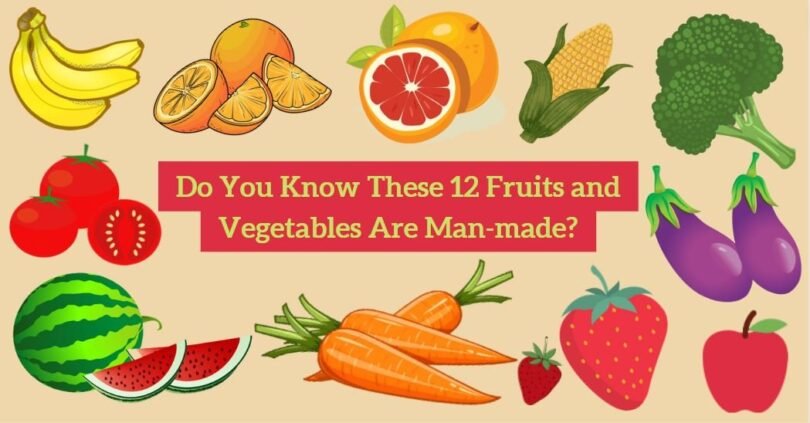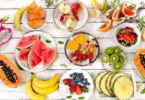Fruits and vegetables are something that we all love and consume. Fruits and vegetables have a number of potent properties that can keep you healthy and avoid sickness. They provide your body with critical nutrients and minerals. Did you know, though, that there are more man-made fruits and vegetables on the market than there are naturally grown ones? Yes! That may come as a shock, but that is the truth.
These are man-made hybrids generated through a selective breeding procedure in which only plants with desirable traits are replanted to reproduce and become food. In some cases, however, insects such as bees are responsible for cross-pollination, which results in hybrids. Let’s take a look at some of the most common man-made hybrids on the market today.
Bananas
Bananas are man-made. If farmers had not invented bananas over 10,000 years ago, they wouldn’t exist now. Today’s bananas are a hybrid of Musa acuminata and Musa balbisiana banana plants. The acuminata has a medicinal taste to it, yet its flesh is creamy and there are few seeds. The balbisiana is sweet and delicious yet seedy, with hard patches on the flesh. When these two were combined, they formed what most of us considered to be the ideal banana.
Watermelons
Watermelons, which have been around for over a millennium, are one of the world’s oldest foods. Watermelons from the past were very different from those available today. Watermelons are believed to have originated in the African deserts. Watermelon farming extended over Europe and North America over the course of around 200 years. Watermelons were discovered in paintings discovered in 4,000+year old Egyptian tombs. Watermelons now come in over 1,200 different forms, sizes, tastes, and textures. However, most people only think of one type-those with red flesh. Ancestors of the watermelon had non-red flesh, a pale color, and so many more seeds.
Apples
The ancestors of this fruit seem very similar to what we can today find. However, the tastes differ. All apples originate from one primary apple type, Malus sieversii. This cultivar was found growing in the wild in Xinjiang, China, Tajikistan, Kazakhstan, Kyrgyzstan, and Uzbekistan. Apples have evolved various tastes and appearances over time depending on where they are cultivated. There are now over 7,500 kinds of this fruit enjoyed by people all over the world.
Tomatoes
This fruit is considered a vegetable by some, and it is one of the oldest vegetables available. Previously, tomatoes were just the size of peas; now, even cherry tomatoes are much larger than them. Tomatoes have undergone significant changes as a result of selective breeding, and samples from now are unlikely to be recognised by the Aztecs who first grew them. The original tomatoes carried back to Spain by Cortez were similar to yellow cherry tomatoes, but smaller. Modern tomatoes were developed to be sweeter and more flavorful.
Carrots
It may be difficult to imagine that now the carrots we see do not resemble natural carrots. They were not at all orange. Natural carrots either were white or purple, and were almost certainly inedible. White carrots were reportedly eaten in the Roman Empire, but historians say they could have been parsnips, white carrots, or even both. The orange carrot is a cross between a yellow carrot and a white carrot. In the 10th century, the earliest known ancestor of the modern consumable carrot appeared in Persia.
Certain accounts claim it was white, while others claim it was purple. Those vegetables, unlike today’s carrots, had a plethora of tiny roots of varied sizes. The Persians carefully bred carrots with the largest roots in order to produce larger roots and, eventually, a single large root. Carrots transformed from white or purple to yellow and then orange as the selective breeding progressed. Carrots were selectively bred until the modern era to increase their flavor and color.
Strawberries
The modern strawberry is a man-made hybrid of the smaller wild strawberry, which has a greater flavor and aroma and a shorter shelf life. In the 18th century, the modern strawberry initially appeared in France. The hybridization programme, on the other hand, started considerably earlier. When botanists in France discovered that wild strawberries could be cloned, they began planting them in their gardens in the 1300s. Unexpectedly, some didn’t yield any fruits at all, and half of those that did couldn’t be closed and stopped producing fruits in the next few years. The French were able to grow wild strawberries up to 20 times their regular size, but they were still tiny. On July 6,1764, Antoine Nicolas Duchesne produced the first modern strawberry by crossing a female Fragaria chiloensis (from Chile) and a male Fragaria moschata.
Eggplants
The original eggplants resembled eggs in their round shape and white color, hence the name eggplant. Eggplants are one of the most widely recognised vegetables, but they used to be pretty different, though. Years of breeding have resulted in the deep purple coloration that eggplants today boast. The earliest colors were yellow and various shades of purple. Eggplants come in a variety of shapes and sizes, including long skinny, short fat, and globe shaped.
Oranges
There are numerous orange varieties available today. Oranges were first grown in Southern China and were afterwards traded all over the world. Briefly said, every orange variety we have today has its origins in the original cross of pomelos and mandarins. The citrus fruit that has many health benefits is a hybrid fruit.
Cabbage
Cabbage is another man-made vegetable. Many vegetables are closely related to the green cole crop. Selective vegetable breeding was popular in the 1600s, when mustard was blended with larger leaf buds, resulting in cabbages.
Corn
Corn as we know it now is a hybrid, but its forebears and origins are unclear. Earlier, natural corn used to be somewhat different from modern corn. Scientists offer differing perspectives on the origins of corn but they all agree that it is a man-made hybrid. Several claim it was derived from the Central American grass teosinte. While several say that corn is related to rice and originated in South America.
Grapefruit
The grapefruit has a long and storied history. When a man named Captain Shaddock shipped some pomelo seeds to the West Indies, he planted seeds next to some orange trees. He discovered the grapefruit that was formed after some cross pollination. Grapefruits initially appeared in Europe in 1750 and were called “forbidden fruit” at the time. The term “grapefruit” was invented in 1814 by John Lunan, a Jamaican planter and magistrate.
Broccoli
Broccoli is a well-known vegetable, and many people are surprised to hear that it is truly man-made. Broccoli is one of numerous hybrids that evolved from the Brassica oleracea or wild mustard family. Over 2500 years ago, the Greeks and Romans began selective breeding these plants, and horticulturists are still working with them now. People began experimenting with enormous flower kinds sometime in the 1600s. Modern-day broccoli is one among the hybrids that emerged during this time period.






